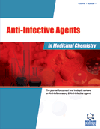- Home
- A-Z Publications
- Anti-Infective Agents in Medicinal Chemistry (Formerly Current Medicinal Chemistry - Anti-Infective Agents)
- Previous Issues
- Volume 7, Issue 1, 2008
Anti-Infective Agents in Medicinal Chemistry (Formerly Current Medicinal Chemistry - Anti-Infective Agents) - Volume 7, Issue 1, 2008
Volume 7, Issue 1, 2008
-
-
Present and Future Treatment of Mycobacteria
More LessAuthors: J. C. Rodriguez, I. Escribano, R. A. Gomez, E. G. Pachon, A. Navarro and G. RoyoTo review the treatments currently used to treat mycobacteria (latent tuberculosis, clinical tuberculosis, infections due to mycobacteria), focussing on : Doses administered and duration of treatment Levels reached in different body tissues in relation to the chemical characteristics of the drugs The relation between these data and the microbiological parameters of each microorganism To review the above parameters for the ne Read More
-
-
-
Recent Advances on Isoniazide Derivatives
More LessAuthors: Jarmila Vinsova, Ales Imramovsky, Josef Jampilek, Juana F. Monreal and Martin DolezalTuberculosis remains the leading cause of mortality worldwide even in the 21st century. This review summarises all facts concerning a front-line antituberculotic drug isoniazide - metabolism, mechanism of activity and resistance. The antimycobacterial pharmacophore moiety of isoniazide has been introduced in a number of various types of molecules (about 510 derivatives have been found) to improve their activity agains Read More
-
-
-
Synthesis and Antibacterial Properties of Oxazolidinones and Oxazinanones
More LessBy Guijun WangOxazolidinones are important synthetic antibacterial agents useful for the treatment of multi antibiotic resistant Gram-positive bacterial infections. Since the launch of Linezolid, the first member of the oxazolidinone antibacterial family, there have been many studies directed towards structural optimization and the development of second generation oxazolidinones. The N-aryl 5-acetamido methyl oxazolidinone is the core struct Read More
-
-
-
The Mode of Inhibition of Mycobacterium tuberculosis Wild-Type and Isoniazid-Resistant 2-Trans-Enoyl-ACP(CoA) Reductase Enzymes by An Inorganic Complex
More LessAuthors: D. S. Santos, I. B. Vasconcelos, E. Meyer, F. A.M. Sales, I. S. Moreira and L. A. BassoTuberculosis (TB) remains the leading cause of mortality due to a single bacterial pathogen, Mycobacterium tuberculosis. The reemergence of tuberculosis as a potential public health threat, the high susceptibility of human immunodeficiency virus-infected persons to the disease, the proliferation of multi-drug-resistant strains (MDR-TB) and, more recently, of extensively drug resistant isolates (XDR-TB) have created a Read More
-
-
-
Enhanced Killing of Intracellular Pathogenic Bacteria by Phenothiazines and the Role of K+ Efflux Pumps of the Bacterium and the Killing Macrophage
More LessAuthors: L. Amaral, M. Martins and M. ViveirosPulmonary tuberculosis is an intracellular infection caused by Mycobacterium tuberculosis. Because its intracellular site is commonly the macrophage of the pulmonary system, and that cell has little killing action of its own, an antibiotic that is to be effective against this organism must be able to penetrate the macrophage and exert its action at the intracellular site where the organism resides. The anti-tubercular drugs Read More
-
Most Read This Month
Article
content/journals/aiamc
Journal
10
5
false
en


